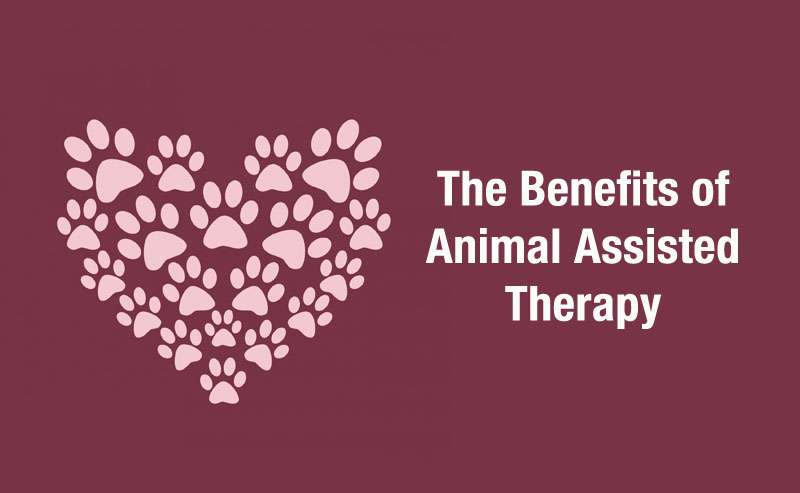
“It is the intuitive power of animals that can help us heal hurts, lessen stress, feel needed, and express our caring side.” Marty Becker, DVM, Resident veterinarian on Good Morning America
Why do people have pets that they feed, walk, play with, and take care of in the same way that might care for a child? Companionship is something that we all long for. Although they were not the perfect match for Adam- before Eve, he was given the task of spending time with and naming all the animals that God had placed around him (Genesis 2:19-20). Companionship was important from the beginning! After all, we were made for it and depend on it for our well-being.
Animal Assisted Therapy (AAT) began in the early 1990s. Since then, however, it has grown in popularity and has gained wide acceptance and is evolving into mainstream psychology. One well-recognized organization in this field explains the process: “The therapy will look much the same as a “traditional” session, except with AAT there is a friendly, calm animal in the room. Sometimes just the presence of the animal creates and facilitates an environment that is conducive to the counseling process. In other cases the therapist will design specific interventions where the client and animal are interacting in some way in order to meet a specific therapeutic goal. For some clients, such as children, adolescents and seniors, the presence of a therapeutic animal can facilitate communication and help ease some of the anxiety or resistance sometimes present,” (www. animalassistedtherapyprograms.org).
Why should I consider this option? Who is AAT best suited for? What are the benefits of this form of therapy? I’m glad you asked! The benefits of AAT are innumerable and diverse, but here are 10 that are related to effective progress in therapy.
1. Reduction in blood pressure
“Vormbrock and Grossberg (1988) assessed heart rate and blood pressure while undergraduates interacted with a dog visually, verbally, or tactually. Blood pressure was highest while talking to the experimenter and lowest during stroking the dog.”
2. Lowered stress and anxiety levels
“Odendaal and Meintjes (2003) assessed changes in plasma cortisol [stress hormone] in dog owners when petting their own, or an unfamiliar dog, or quietly reading a book. The interaction with their own dog, and also with the unfamiliar dog, but not the reading condition led to a significant decrease in the cortisol levels of the humans.”
3. Enhanced self esteem
“AAT also allows children an outlet for the loving part of themselves and helps them control and regulate their own behavior while developing empathy toward other living creatures (Gonski, 1985). Through successes with the animal, many children are able to increase their self-esteem and thereby have more confidence when approaching new tasks.”
4. Increased emotional awareness and regulation
“In psychiatric inpatients, however, AAT lead to a significant increase in interactions with other patients over the course of 4 weeks in comparison to rehabilitation without animals. This included smiles, sociability, helpfulness toward others, activation and responsiveness (Marr et al., 2000).”
5. Reduced aggression
“Effects of the presence of friendly dogs on aggressive behavior in a classroom of first-graders were investigated via behavior observation and reports of the classroom teacher (Hergovich et al.,2002; Kotrschal and Ortbauer, 2003). In the presence of the dog, in comparison to its absence, aggressive behavior was decreased.
6. Reduced loneliness
“Wells (2004) studied the behavior of 1800 strangers toward a female experimenter in six different conditions: accompanied by a Labrador retriever pup, by an adult Labrador, by an adult Rottweiler, being in the presence of a teddy bear or a plant, or being alone as control conditions. In the alone condition, the experimenter was ignored more than with the teddy or plant, but got more attention in the company of a dog. The Rottweiler led to more non-responses than the pup or the adult Labrador, which elicited most smiles and verbal responses.”
7. Improved immune system
“Only one study assessing parameters of the immune system met our inclusion criteria. Charnetski et al. (2004) reported a significant increase in salivary immunoglobulin A (IgA), an indicator of good immune system functioning, in college students after stroking a live dog in comparison to stroking a stuffed dog or sitting quietly for 18 min.”
8. Increased trust and trustworthiness
“Gueguen and Cicotti (2008) investigated the influence of the presence or absence of a dog on social interaction, helping, and courtship behavior. In four different experiments, experimenters asked strangers for money in the street, young women for their phone numbers in public or observed whether people would help to pick up coins a male experimenter dropped on the street. The presence of the dog was linked to a higher compliance with the request for the phone number and a higher rate of helping behavior. In particular the compliance with the request for the phone number can be interpreted as an indication for increased trust and maybe also attraction of the strangers toward an unfamiliar man accompanied by a dog, which probably promoted his perception as a trustworthy person. These first findings indicate a sociopositive effect of dogs on trust and prosocial behavior”
9. Reduction of depression
“Elderly residents of an institution experienced a reduction in depression and improvement in quality of life when caring for a canary for a period of 3 months (Colombo et al., 2006). A companion bird also reduced depression in elderly adults after admission to a skilled rehabilitation unit (Jessen et al., 1996).”
10. Stimulates positive communication
“An unexpected benefit included an increase number of spontaneous communication initiations produced during sessions; dog may act as a unique catalyst to motivate client and provide an atmosphere of unconditional acceptance for disordered speech.”
As you can see, it is advantageous to pursue AAT as a therapeutic option because of the positive physical, mental, and emotional effects on the body. For more information about how to get involved in this form of therapy, look at our animal assisted therapy near me page.
References:
(Cardiovascular effects of human-pet dog interactions. Vormbrock JK, Grossberg JM J Behav Med. 1988 Oct; 11(5):509-17.)
(Neurophysiological correlates of affiliative behaviour between humans and dogs. Odendaal JS, Meintjes RA Vet J. 2003 May; 165(3):296-301.)
(Gonski, Y (1985). The therapeutic utilization of canines in a child welfare setting. Child Adolescent Social Work J. 2(2), 93-105.)
(Marr C. A., French L., Thompson D., Drum L., Greening G., Mormon J., Hughes C. W. (2000). Animal-assisted therapy in psychiatric rehabilitation. Anthrozoos 13, 43–3710.2752/089279300786999950)
(Hergovich A., Monshi B., Semmler G., Zieglmayer V. (2002). The effects of the presence of a dog in the classroom. Anthrozoos 15, 37–5010.2752/089279302786992775; Kotrschal K., Ortbauer B. (2003). Behavioral effects of the presence of a dog in a classroom. Anthrozoos 16, 147–15910.2752/089279303786992170)
(Wells D. L. (2004). The facilitation of social interactions by domestic dogs. Anthrozoos 17, 340–35210.2752/089279304785643203)
(Effect of petting a dog on immune system function. Charnetski CJ, Riggers S, Brennan FX Psychol Rep. 2004 Dec; 95(3 Pt 2):1087-91.)
(Gueguen N., Cicotti S. (2008). Domestic dogs as facilitators in social interaction: an evaluation of helping and courtship behaviors.Anthrozoos 21, 339–34910.2752/175303708X371564)
(Pet therapy and institutionalized elderly: a study on 144 cognitively unimpaired subjects. Colombo G, Buono MD, Smania K, Raviola R, De Leo D Arch Gerontol Geriatr. 2006 Mar-Apr; 42(2):207-16.; Avian companionship in alleviation of depression, loneliness, and low morale of older adults in skilled rehabilitation units. Jessen J, Cardiello F, Baun MM Psychol Rep. 1996 Feb; 78(1):339-48.)
(Macauley, B. L. (2006). Animal-assisted therapy for persons with aphasia: A pilot study. Journal of rehabilitation research and development, 43(3), 357).
(Beetz, A., Uvnäs-Moberg, K., Julius, H., & Kotrschal, K. (2012). Psychosocial and Psychophysiological Effects of Human-Animal Interactions: The Possible Role of Oxytocin. Frontiers in Psychology, 3, 234. doi:10.3389/fpsyg.2012.00234)
Animal therapy or pet therapy refers to the use of animals as a way to help people cope with and recover from some physical and mental health conditions.
Depending on the function of the therapy, people may choose from various animals, including dogs, horses, and birds. Animal assisted therapy is not the only therapeutic option in most cases, but it can be a good choice for some people.
Keep reading to learn more, including how it works, who it may benefit, and more.
What is it?

Share on Pinterest
Interacting with professionally trained dogs, horses, and birds may help people with physical or mental health conditions.
Animal therapy, also called pet therapy or animal assisted therapy, refers to various services using animals to help people with specific physical or mental health conditions.
Animals may be able to provide comfort, alert others if someone is in danger, or even perform direct actions to help a person’s condition when they are in need. It is a type of complementary or alternative therapy. It should enhance but not replace other treatments.
On the whole, the goal of animal assisted therapy is to alleviate or help people cope with some symptoms of various conditions where possible.
The exact type of animal therapy can vary greatly depending on what condition the person has, the type of animal, and what kind of therapy they provide.
Animal therapy builds on a concept called the human-animal bond, which describes people’s desire to interact with and relate to animals. For many people, by interacting with a friendly animal, they can form a bond with them. This bond can produce a calming state in the person.
This bond itself may help the person in several ways, such as:
- reducing boredom
- increasing movement and activity through walks and play
- providing companionship and decreasing loneliness
- increasing social interactions
- improving mood and general well-being
The positive interactions with an animal may lead to benefits in the mind and body, such as reduced stress and an overall more balanced mental and emotional state.
Animal therapy partially uses this bond in a directed way to achieve the goals of the therapy.
How does it work?
Animal therapy can have several goals, and these will determine how it works. The type of therapy and target for this therapy may change depending on the condition and the type of aid that a person needs. Some examples include:
- providing comfort and reducing levels of pain
- improving movement or motor skills
- developing social or behavioral skills
- increasing motivation toward activities such as exercise or interacting with others
The process of animal therapy itself typically involves the animal’s handler, who is often the owner, bringing the animal to each session. The handler will work under a doctor’s guidance to help the person achieve the goals of their therapy.
A number of organizations train handlers and connect them to healthcare providers. Many handlers work as volunteers. Before getting approval for therapy use, both the animal and the handler will have to go through various certifications with these groups and organizations.
The handler must generally pass an instructional course on how to interact with people and perform the types of therapies that they may provide.
The animal also has to go through certain checks. These will include checking immunization records and performing physical exams to ensure that the animal is generally healthy and free of disease. They will also have to undergo temperament testing to make sure that they behave properly with both the handler and other people.
Additionally, the pair will go through obedience training. This rigorous testing and certification ensures the safety and professionalism of everyone involved and helps give the person access to the best therapy sessions possible.
It is important to note that a therapy dog is not the same as a service dog and does not have all of the same rights. For example, a therapy dog cannot accompany a handler into a business establishment.
Who might benefit?
Animal therapy may help people with a range of health issues.
Mental health
The Pet Partners organization note that these therapies may improve many important markers of stress and disorder by:
- decreasing anxiety and stress
- decreasing perceptions of pain
- reducing feelings of fear or worry
- increasing feelings of social support
- providing motivation, stimulation, and focus
A review study notes that animal therapy appears to provide general benefits for both physical and psychological health. Evidence for animal assisted therapy appears strongest for markers of anxiety and depression in the widest range of people.
The researchers note that the therapy may be beneficial for people from many different age groups with various conditions. For example, a 2019 study found that the use of therapy dogs improved the efficacy of mental health treatments among adolescents.
Together, these factors may make the therapy helpful for aspects of conditions such as:
- dementia
- depression
- anxiety
- autism spectrum disorder
- attention deficit hyperactivity disorder (ADHD)
- schizophrenia
Studies involving the use of therapy horses and dogs have shown that animal therapy might also help alleviate the symptoms of post-traumatic stress disorder (PTSD).
Some people going through rehabilitation for a drug use disorder may also respond well and have a greater sense of well-being when working with an animal.
Physical health
Some forms of animal therapy may also help with markers of physical conditions, including:
- epilepsy
- heart failure
- pain from cancer treatment
- postoperative recovery
- recovery after a major stroke or another condition that causes a person to lose motor skills
Working with an animal in these cases may motivate the person to continue therapy, boost their mood, and reduce signs of pain. For physical conditions, it may help them move correctly and exercise often.
Additionally, some long-term care facilities may offer pet therapy programs to help improve the mood and general well-being of people in these facilities.
A study in Psychogeriatrics found that dog assisted therapy in long-term elderly care facilities helped reduce symptoms of depression. The research suggests that the dogs help facilitate social interaction and create positive emotional responses.
However, more research is necessary to confirm the benefits of animal therapy.
Risks
While animal therapy may be helpful for people with certain health issues, it may not be right for everyone.
Some people may be allergic to the animals that commonly play a role in therapy. Many people are allergic to the dander from a dog’s shedding, for example. For these individuals, animal therapy with a dog could cause far more harm than good.
Others may simply be uncomfortable with or afraid of the animals. They may not choose this type of therapy as it would cause them more stress.
In some cases, a person may become very attached to the animal rather quickly. This feeling could lead to possessiveness or actually decrease a person’s satisfaction with therapy.
Additionally, therapy animals that visit hospitals and other long-term facilities may be carriers of certain infections or diseases. There may be a chance of them spreading these infections to other people, making thorough testing important for any animal.
Alternatives
Animal therapy is a complementary treatment. It is not a basis for the treatment of any condition and should only enhance or complement other treatment. It is not a replacement for other forms of therapy, such as psychotherapy or physical therapy.
This form of therapy might not suit everyone, however. People who do not respond well to animal therapy or are not interested in trying it may ask about other options. These alternatives will vary depending on the person’s condition.
Learn more about several types of therapy options here.
Summary
Animal therapy involves regular sessions with professionally trained animals and their handlers. It aims to help people cope with both physical and mental health disorders.
Doctors or mental health specialists may recommend and administer animal therapy for various conditions, with different goals in mind for each person.
Some people may not enjoy animal therapy or have other reasons to avoid it, and they can choose from alternative therapies.
Anyone considering animal therapy should discuss the process and how they may benefit from it with a doctor or mental health specialist.




